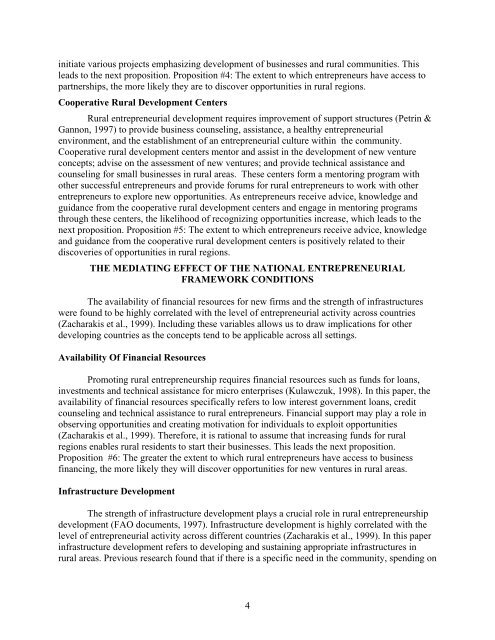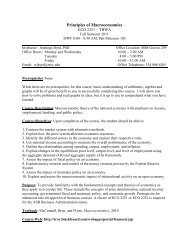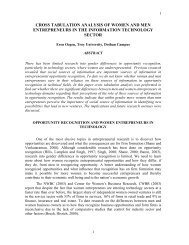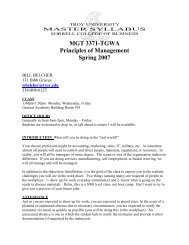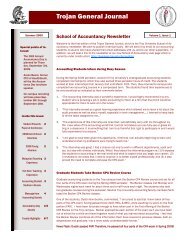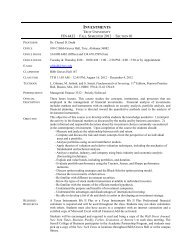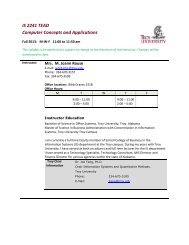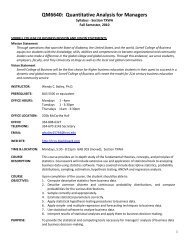a framework to support entrepreneurial development in rural
a framework to support entrepreneurial development in rural
a framework to support entrepreneurial development in rural
You also want an ePaper? Increase the reach of your titles
YUMPU automatically turns print PDFs into web optimized ePapers that Google loves.
<strong>in</strong>itiate various projects emphasiz<strong>in</strong>g <strong>development</strong> of bus<strong>in</strong>esses and <strong>rural</strong> communities. Thisleads <strong>to</strong> the next proposition. Proposition #4: The extent <strong>to</strong> which entrepreneurs have access <strong>to</strong>partnerships, the more likely they are <strong>to</strong> discover opportunities <strong>in</strong> <strong>rural</strong> regions.Cooperative Rural Development CentersRural <strong>entrepreneurial</strong> <strong>development</strong> requires improvement of <strong>support</strong> structures (Petr<strong>in</strong> &Gannon, 1997) <strong>to</strong> provide bus<strong>in</strong>ess counsel<strong>in</strong>g, assistance, a healthy <strong>entrepreneurial</strong>environment, and the establishment of an <strong>entrepreneurial</strong> culture with<strong>in</strong> the community.Cooperative <strong>rural</strong> <strong>development</strong> centers men<strong>to</strong>r and assist <strong>in</strong> the <strong>development</strong> of new ventureconcepts; advise on the assessment of new ventures; and provide technical assistance andcounsel<strong>in</strong>g for small bus<strong>in</strong>esses <strong>in</strong> <strong>rural</strong> areas. These centers form a men<strong>to</strong>r<strong>in</strong>g program withother successful entrepreneurs and provide forums for <strong>rural</strong> entrepreneurs <strong>to</strong> work with otherentrepreneurs <strong>to</strong> explore new opportunities. As entrepreneurs receive advice, knowledge andguidance from the cooperative <strong>rural</strong> <strong>development</strong> centers and engage <strong>in</strong> men<strong>to</strong>r<strong>in</strong>g programsthrough these centers, the likelihood of recogniz<strong>in</strong>g opportunities <strong>in</strong>crease, which leads <strong>to</strong> thenext proposition. Proposition #5: The extent <strong>to</strong> which entrepreneurs receive advice, knowledgeand guidance from the cooperative <strong>rural</strong> <strong>development</strong> centers is positively related <strong>to</strong> theirdiscoveries of opportunities <strong>in</strong> <strong>rural</strong> regions.THE MEDIATING EFFECT OF THE NATIONAL ENTREPRENEURIALFRAMEWORK CONDITIONSThe availability of f<strong>in</strong>ancial resources for new firms and the strength of <strong>in</strong>frastructureswere found <strong>to</strong> be highly correlated with the level of <strong>entrepreneurial</strong> activity across countries(Zacharakis et al., 1999). Includ<strong>in</strong>g these variables allows us <strong>to</strong> draw implications for otherdevelop<strong>in</strong>g countries as the concepts tend <strong>to</strong> be applicable across all sett<strong>in</strong>gs.Availability Of F<strong>in</strong>ancial ResourcesPromot<strong>in</strong>g <strong>rural</strong> entrepreneurship requires f<strong>in</strong>ancial resources such as funds for loans,<strong>in</strong>vestments and technical assistance for micro enterprises (Kulawczuk, 1998). In this paper, theavailability of f<strong>in</strong>ancial resources specifically refers <strong>to</strong> low <strong>in</strong>terest government loans, creditcounsel<strong>in</strong>g and technical assistance <strong>to</strong> <strong>rural</strong> entrepreneurs. F<strong>in</strong>ancial <strong>support</strong> may play a role <strong>in</strong>observ<strong>in</strong>g opportunities and creat<strong>in</strong>g motivation for <strong>in</strong>dividuals <strong>to</strong> exploit opportunities(Zacharakis et al., 1999). Therefore, it is rational <strong>to</strong> assume that <strong>in</strong>creas<strong>in</strong>g funds for <strong>rural</strong>regions enables <strong>rural</strong> residents <strong>to</strong> start their bus<strong>in</strong>esses. This leads the next proposition.Proposition #6: The greater the extent <strong>to</strong> which <strong>rural</strong> entrepreneurs have access <strong>to</strong> bus<strong>in</strong>essf<strong>in</strong>anc<strong>in</strong>g, the more likely they will discover opportunities for new ventures <strong>in</strong> <strong>rural</strong> areas.Infrastructure DevelopmentThe strength of <strong>in</strong>frastructure <strong>development</strong> plays a crucial role <strong>in</strong> <strong>rural</strong> entrepreneurship<strong>development</strong> (FAO documents, 1997). Infrastructure <strong>development</strong> is highly correlated with thelevel of <strong>entrepreneurial</strong> activity across different countries (Zacharakis et al., 1999). In this paper<strong>in</strong>frastructure <strong>development</strong> refers <strong>to</strong> develop<strong>in</strong>g and susta<strong>in</strong><strong>in</strong>g appropriate <strong>in</strong>frastructures <strong>in</strong><strong>rural</strong> areas. Previous research found that if there is a specific need <strong>in</strong> the community, spend<strong>in</strong>g on4


